Seven Questions Over Breakfast with Marie-Louise Gay
 April 21st, 2015 by jules
April 21st, 2015 by jules
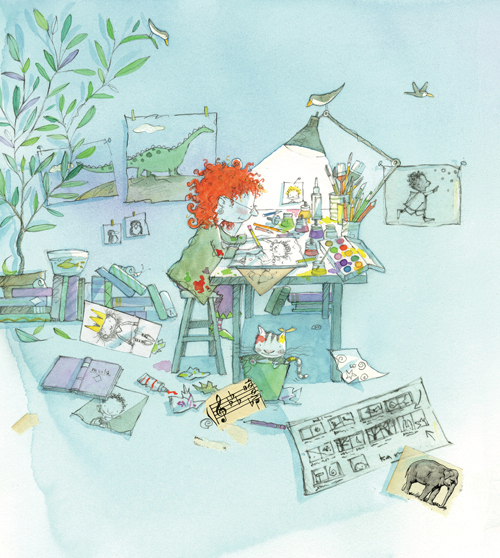
a shy young giant with birds nesting in his hair. His story starts here …”
If you saw last year’s Any Questions?, written and illustrated by Canadian Marie-Louise Gay, who has been nominated for the Astrid Lindgren Memorial Award and the Hans Christian Andersen Award, you may recognize the above illustration. It’s from the book, and it’s Marie-Louise herself, hard at work in her studio. (Some of my favorite illustrator interviews have been the ones where artists send illustrated “author photos,” but I digress.)
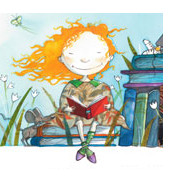 Any Questions?—a finalist for Canada’s 2014 Governor General’s Literary Award for Children’s Illustration, as well as a School Library Journal Best Book of the Year and a Kirkus Reviews Best Book of the Year—was released last August by Groundwood Books, and it was then that I contacted Marie-Louise about an interview. I’ve admired her work over the years, and then along comes this excellent book, an exploration of what it means to be creative, as well as imagined conversations with children about writing and creating art — ones based on real conversations she’s had at school visits over the years. Booklist praised the book’s “empowering” message — “that creativity is messy and fun!” Hear hear.
Any Questions?—a finalist for Canada’s 2014 Governor General’s Literary Award for Children’s Illustration, as well as a School Library Journal Best Book of the Year and a Kirkus Reviews Best Book of the Year—was released last August by Groundwood Books, and it was then that I contacted Marie-Louise about an interview. I’ve admired her work over the years, and then along comes this excellent book, an exploration of what it means to be creative, as well as imagined conversations with children about writing and creating art — ones based on real conversations she’s had at school visits over the years. Booklist praised the book’s “empowering” message — “that creativity is messy and fun!” Hear hear.
Yes, that was last year. Sometimes I get busy. But better late than never. But she’s also just released (this month, in fact) the adventure novel The Traveling Circus, written with her partner, David Homel, and also published by Groundwood. So, I meant to post this interview so late. Yes, I MEANT TO DO THAT. (Ahem.)
When I asked Marie-Louise about her published books thus far in her career, a question I ask everyone, she sent me a comprehensive bibliography, which I’m not including at the bottom of this post, only because it refuses to format properly for me. But trust me when I say it’s a long list; her first illustrated book was in 1976, as those of you who have followed her career closely know well. She’s spent decades capturing, with her warm watercolor illustrations, the wonders of childhood and nature. There is a spontaneity and energy to her work that really shines.
We’re having her preferred breakfast today — an orange, granola, yogurt, and a strong coffee. “Strong” coffee? An illustrator after my own heart. Let’s get right to it, and I thank her for visiting and sharing art. …
Jules: Are you an illustrator or author/illustrator?
Marie-Louise: Author/Illustrator.
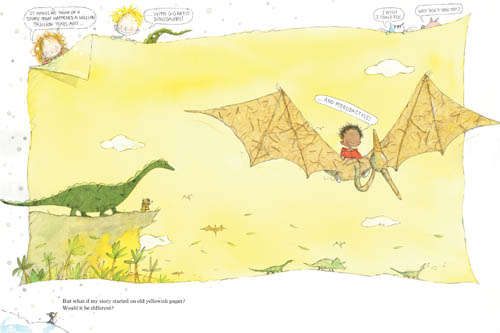
“But what if my story started on old yellowish paper? …”
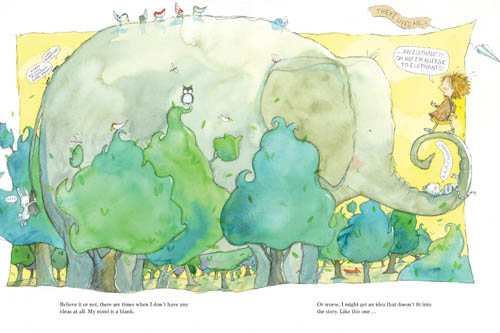
“Believe it or not, there are times when I don’t have any ideas at all.
My mind is a blank. …”

“So I have to use my imagination. Try out new ideas. …”
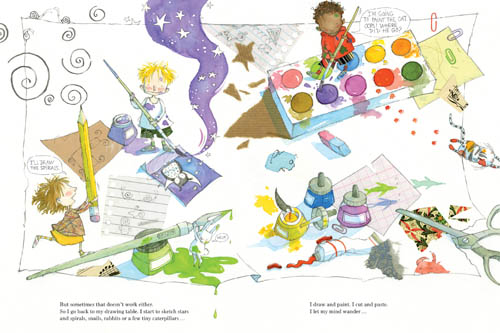
“But sometimes that doesn’t work either.
So I go back to my drawing table. …”
Jules: Can you list your books-to-date? (If there are too many books to list here, please list your five most recent illustrated titles or the ones that are most prominent in your mind, for whatever reason.)
Marie-Louise: [See the “Books” link at Marie-Louise’s site.]
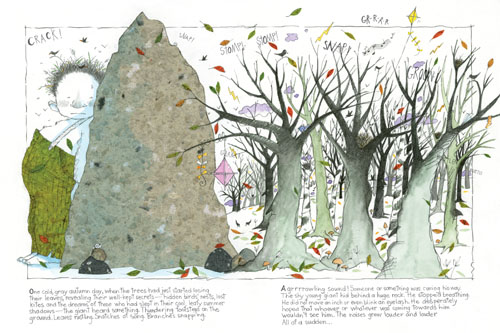
“One cold, gray autumn day, when the trees had just started losing their leaves, revealing their well-kept secrets—hidden birds’ nests, lost kites and the dreams of those who had slept in their cool, leafy summer shadows—
the giant heard something. …”

“I wonder if this green is slimy enough? …”

“‘Who are you?’ asked the giant.
‘I’m a beast,’ whispered the beast. ‘A horrible, dreadful beast. …'”
Jules: What is your usual medium?
Marie-Louise: Watercolor is my preferred medium, but I use it in conjunction with pencil, colored pencils (Caran d’Ache Supracolor), pastels, acrylic, gouache, collage, and ink.

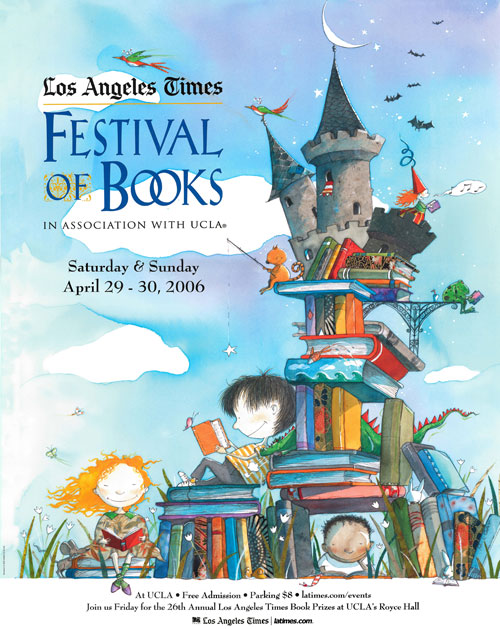
Jules: If you have illustrated for various age ranges (such as, both picture books and early reader books OR, say, picture books and chapter books), can you briefly discuss the differences, if any, in illustrating for one age group to another?
Marie-Louise: I have illustrated both board books and picture books, as well as early reader books and chapter books. I can’t say that there is such a big difference between illustrating early reader books and chapter books. The difference would not be illustrating for one age group or another but, in the case of the picture book, where the visual vocabulary (the art) is much richer than the the text. It enables the child who cannot yet read, or has difficulty in reading, to understand the story through it’s visual clues, body language and facial expressions of the characters, the details, etc. My goal when I write and illustrate a picture book is to be spare with words and eloquent in my art.
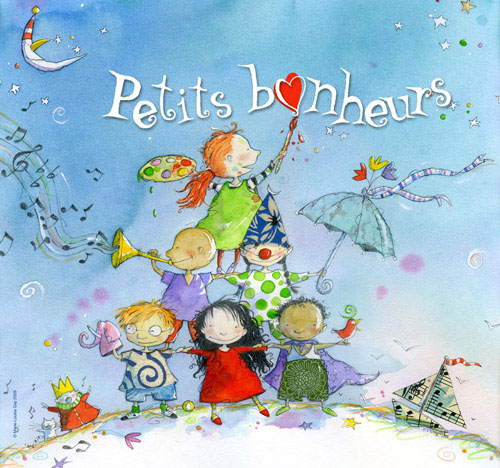

Jules: Where are your stompin’ grounds?
Marie-Louise I live in Montréal, province of Québec, Canada.
Jules: Can you briefly tell me about your road to publication?
Marie-Louise: I started drawing when I was sixteen years old, doodling on my textbooks, sketching on paper napkins or on any available and relatively flat surface. I opted for art school. After studying graphic design, animation, drawing, and photography, I started doing various cartoon strips for local magazines and newspapers while I was still in school. I branched out towards editorial illustration for magazines in Canada and the U.S.: Saturday Night, Mother Jones, Psychology Today, etc.
I was approached a few years later by a publisher and author of children’s books who asked me to illustrate one of his picture-book manuscripts — then a second one and a third. The experience was exhilarating. I fell in love with exploring a story in pictures, creating a visual vocabulary, creating characters that evolved in a landscape that I had invented. It didn’t take too long before I was tempted to try my hand at writing my own stories.


Jules: Can you please point readers to your web site and/or blog?
Marie-Louise: www.marielouisegay.com.
Jules: If you do school visits, tell me what they’re like.
Marie-Louise: I don’t do as many school visits as I used to, but I still enjoy doing them. My preference goes to smaller groups, one or two classes, because I find that interactive presentations are much more fun and inspiring. I start by describing what an author/illustrator’s life is like (normal except for the fact that I have no boss, no office hours, and I spend the day alone in my studio, doodling and writing and daydreaming). I talk about the creative process. I show them sketches, storyboards, colored sketches, and original drawings. I read them a story or two. I sometimes do a drawing, using the kid’s suggestions, or write an interactive story with them. Other times we improvise a play with characters that I have just created in front of them and to whom they give life. I answer as many questions as I can.
Jules: If you teach illustration, by chance, tell me how that influences your work as an illustrator.
Marie-Louise: I taught illustration for ten years at the Université du Québec in Montréal, but that was twenty years ago. At the time, I felt that all the research I did to build my classes was very inspiring and enriched my work greatly.
Jules: Any new titles/projects you might be working on now that you can tell me about?
Marie-Louise: I have just finished illustrating a picture book for Candlewick, Press called Tiger and Badger by Emily Jenkins. It will be published in February 2016.
I am also exploring, sketching, and writing a book of short illustrated cartoon stories. I’m in the middle of the ninth draft of a puppet play. I am revising a new chapter book in the Travels with my Family series (co-written with my partner, David Homel). The Traveling Circus published just this month.
 Okay, we’ve got more coffee, and it’s time to get a bit more detailed with six questions over breakfast. I thank Marie-Louise again for visiting 7-Imp.
Okay, we’ve got more coffee, and it’s time to get a bit more detailed with six questions over breakfast. I thank Marie-Louise again for visiting 7-Imp.
1. Jules: What exactly is your process when you are illustrating a book? You can start wherever you’d like when answering: getting initial ideas, starting to illustrate, or even what it’s like under deadline, etc. Do you outline a great deal of the book before you illustrate or just let your muse lead you on and see where you end up?
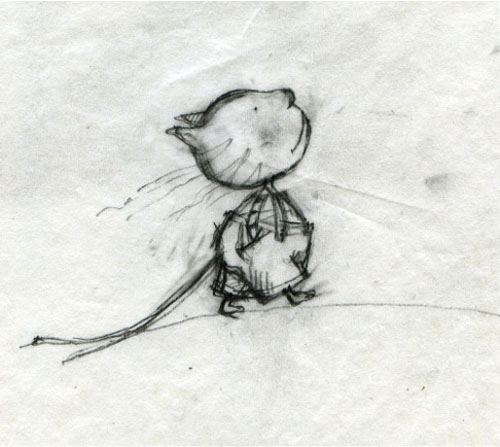
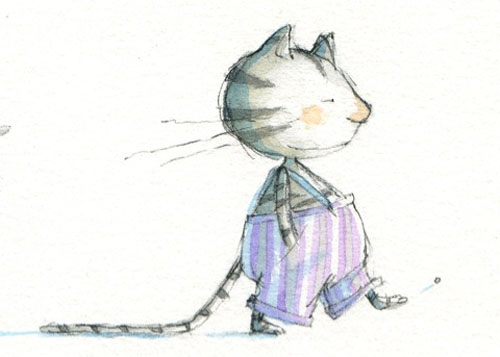
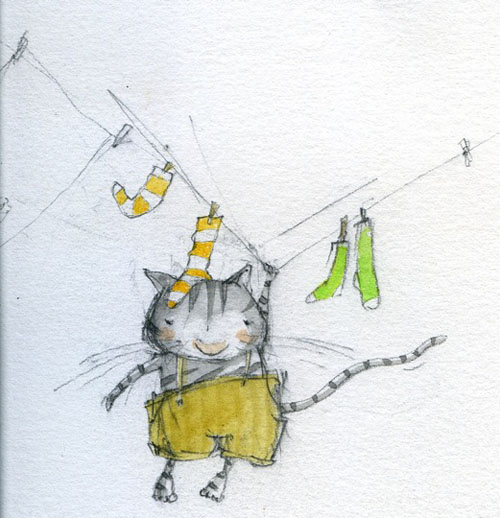
Marie-Louise: When I am asked to illustrate someone else’s story, the process starts immediately as I read the manuscript for the first time. If I don’t instantly see images in my mind as I read it, it is usually a sign that this particular story is not for me. At the second reading, I am already doing thumbnail sketches of key parts of the story or of the main character, in pencil right on the paper manuscript. Then, once everything is settled—contract, advance, due date, etc.—the first thing I do is a quite detailed storyboard of the book on the layout provided by the art director, and then I start looking for ways of escaping the imposed layout, letting my sketching guide me, trying out different points of view — but always within the confines of the story, of course.
It is quite a different process when I write and illustrate my own story. I feel more at liberty to improvise, to try new paths, to let my illustration change the story, and vice versa. It is a process of osmosis, much more organic then when I am illustrating an another author’s story.

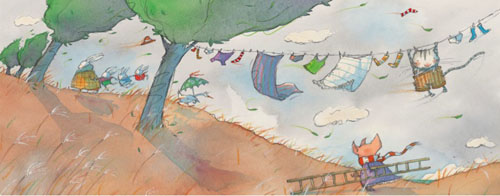
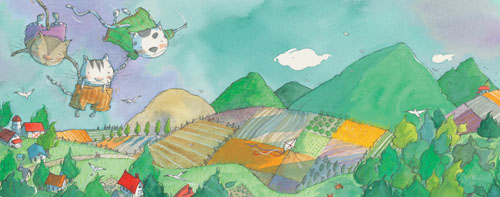
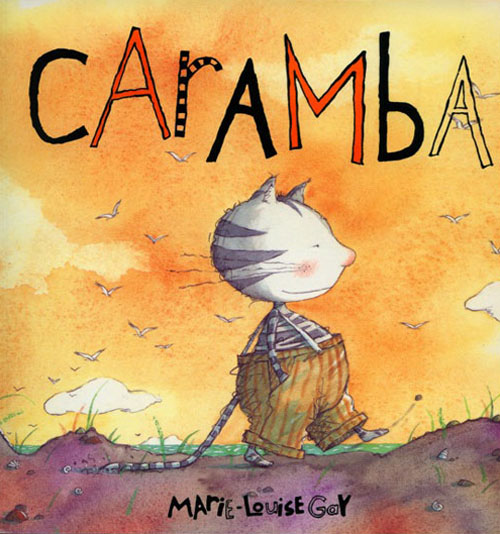
2. Jules: Describe your studio or usual work space.
Marie-Louise: A small light-filled studio on the second floor of our tiny, century-old red brick house. The large windows look over scruffy urban gardens, shadowed by large maple trees, and an alleyway where dozens of children play, laugh, scream, climb trees, skateboard, play tag or hide and seek. In the summer I am hidden in a sea of green leaves, and in the winter, a storm of snowflakes. I am surrounded by books, notebooks, art books, design books, children’s books, old magazines and encyclopedias or animal books and my art materials — jars of paintbrushes or colored pencils, bottles of ink, tubes of watercolor paints or acrylics, scraps of paper. An immense wooden chest of drawers that was used to store priests’ vestments in a sacristy now holds hundreds of sheets of paper of every size, shape, texture and color, as well as my artwork. My computer is in another room to keep distractions to a minimum. The walls are covered in sketches and artwork, and taped or pinned on the wall nearest to my drawing table is the project I am working on: storyboards, sketches, or final artwork.
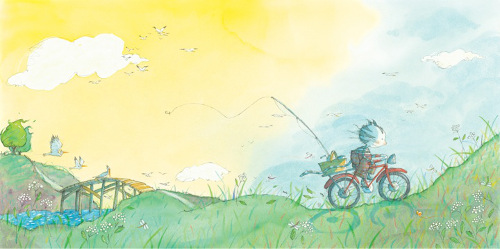
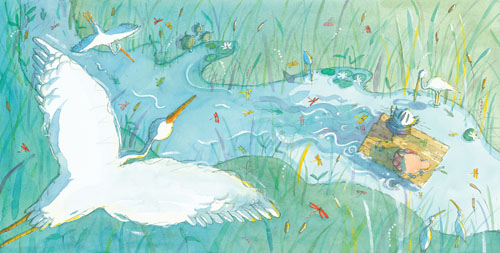
3. Jules: As a book-lover, it interests me: What books or authors and/or illustrators influenced you as an early reader?
Marie-Louise: I grew up speaking French at home and did most of my primary schooling in English, so I read both in English and French. Babar, Curious George, Martine à la Plage, Grimms’ fairytales, as well as Hans Christian Andersen, Tintin, Nancy Drew, C. S. Lewis. I was fascinated by the detailed illustrations in the Babar stories or in the Tintin books.
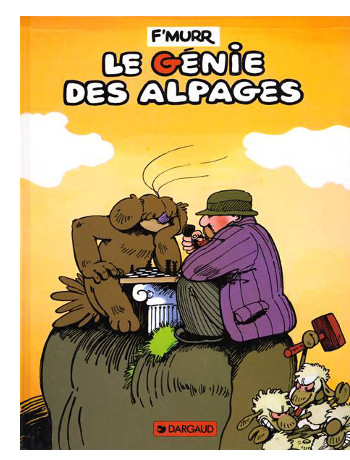 But the real turning point was in my early teens when I immersed myself in the worlds of Ursula K. Le Guin or John Wyndham, and at the same time I was mesmerized by the surrealistic, achingly funny, intellectual, and visual musings of the french bédéistes (in English, this could translate as perhaps cartoonists or precursors of the graphic novel?): F’Murr with his Génie des alpages; Claire Bretécher and her Cellulite; Mandryka with his Concombre Masqué; Gotlib; Jean-Michel Folon.
But the real turning point was in my early teens when I immersed myself in the worlds of Ursula K. Le Guin or John Wyndham, and at the same time I was mesmerized by the surrealistic, achingly funny, intellectual, and visual musings of the french bédéistes (in English, this could translate as perhaps cartoonists or precursors of the graphic novel?): F’Murr with his Génie des alpages; Claire Bretécher and her Cellulite; Mandryka with his Concombre Masqué; Gotlib; Jean-Michel Folon.
My sources of inspiration expanded as I attended different art schools in Montréal and San Francisco. I poured over Saul Steinberg’s and Ralph Steadman’s drawings. I discovered the quirky, wonderful world of Edward Gorey, the inventiveness of André François, the bold designs of Tomi Ungerer, the weird illustrations of Ian Pollock. I was influenced by painters who “illustrated,” who told a story: Fernando Botero, Edward Hopper, David Hockney. And as it became clear to me that writing and illustrating books for children were my main interest and passion, I was absorbing the perfect twinning of art and story in the humourous and lively illustrations of Tony Ross and Quentin Blake; the painstakingly detailed drawings by Chris Van Allsburg; the gentle, emotional, funny books illustrated by André Dahan, William Steig, and Rosemary Wells. I especially admired the eastern Europeans — Helme Heine, Wolf Erlbruch, Lisbeth Zwerger, Henrik Drescher, Klaus Ensikat, and Květa Pacovská.
In Canada, I poured over Ken Nutt’s enchantingly detailed Zoom illustrations; I was inspired by Michèle Lemieux’s colours and light and masterful drawing technique; and Pierre Pratt’s quirky vision of the world. I was enthralled by the lovely energy and vivacity of Katy MacDonald Denton’s children and animal characters.
This list is far from exhaustive, and the more I think about it, the more images float to my mind. All these artists’ works have become part of my visual memory and vocabulary. This is where I have found find part of my inspiration.

the Biggest Hole on Earth! (Groundwood, 2010)
4. Jules: If you could have three (living) authors or illustrators—whom you have not yet met—over for coffee or a glass of rich, red wine, whom would you choose? (Some people cheat and list deceased authors/illustrators. I won’t tell.)
Marie-Louise: Edward Gorey, Shaun Tan, and Lisbeth Zwerger. But I would prefer seeing them individually and in their respective studios. (Edward Gorey might be difficult to meet!)
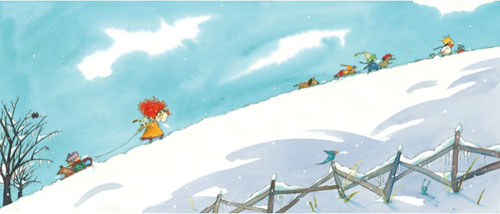
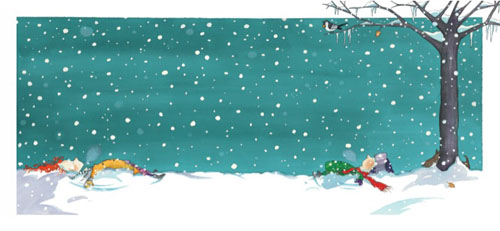
Stella, Queen of the Snow (Groundwood, 2010)
5. Jules: What is currently in rotation on your iPod or loaded in your CD player? Do you listen to music while you create books?
Marie-Louise: I only listen to music or the radio when I am applying colors or collage on an illustration: I want my mind to work instinctively when I paint. I want my choices and juxtaposition of colors to emerge from my subconscious. So while my mind is following a certain beat, a rhythm, a train of thought, a poetic turn of phrase, surprising colors, or odd combinations, lovely and spontaneous mistakes subtly make their way into my illustrations. I might listen to , Cat Power, Miles Davis, Glenn Gould, Lightnin’ Hopkins, Joan Osborne, Leonard Cohen, Lucinda Williams, Manu Chao, and more. But I need total silence when I am writing, storyboarding, or exploring a story’s twists and turns.
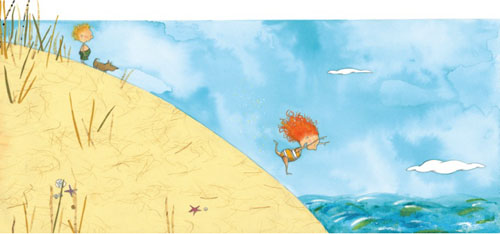
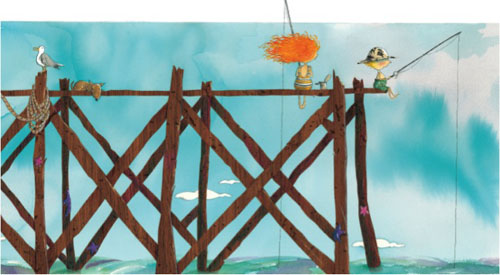
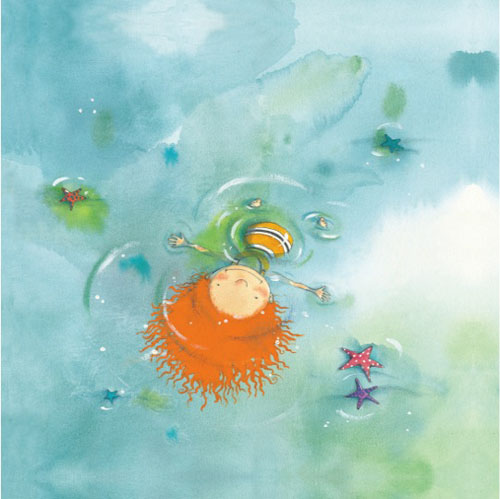
Stella, Star of the Sea (Groundwood, 2010)
6. Jules: What’s one thing that most people don’t know about you?
Marie-Louise: That I am constantly anthropomorphizing birds, cats, trees, sheep, objects etc. — creating conversations between them, giving them thoughts and emotions, and imagining their lives and adventures.
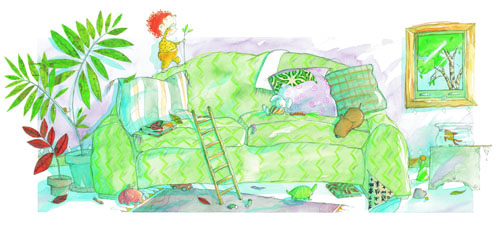
When Stella Was Very, Very Small (Groundwood, 2011)

Jules: What is your favorite word?
Marie-Louise: “Serpentine.”
Jules: What is your least favorite word?
Marie-Louise: “Compulsory.”
Jules: What turns you on creatively, spiritually or emotionally?
Marie-Louise: A vast, luminous landscape of mountains. Or a starry, moonlit sky over the ocean.
Jules: What turns you off?
Marie-Louise: Crass commercialism.
Jules: What sound or noise do you love?
Marie-Louise: The beat of a bird’s wings flying overhead in an early morning sky.
Jules: What sound or noise do you hate?
Marie-Louise: Loud racing car engines.
Jules: What profession other than your own would you like to attempt?
Marie-Louise: Actor, architect, explorer, sculptor, ceramist.
Jules: What profession would you not like to do?
Marie-Louise: Politician.
All images are used by permission of Marie-Louise Gay.
The spiffy and slightly sinister gentleman introducing the Pivot Questionnaire is Alfred, copyright © 2009 Matt Phelan.

This artwork is simply amazing and I’m scratching my head as to how I could’ve missed seeing ANY QUESTIONS?! I have GOT to get my hands on that book!
And Marie-Louise, is “Serpentine” your favorite word because of that scene in “The In-Laws” with Peter Falk and Alan Arkin? That’s the first thing that came to mind ’cause I LOVE that scene AND the movie 🙂
Thanks for this great interview, ladies!
This lovely review or M Louise Gay’s work is beyond pleasant and delightful color and creativity. The article is good reading. ATK
[…] How to Find Gold (Candlewick, March 2016); Emily Jenkins’ Tiger and Badger, illustrated by Marie-Louise Gay (Candlewick, February 2016); and Peter McCarty’s Bunny Dreams (Henry Holt, January 2016). […]
[…] pretty great — Jessixa Bagley’s Laundry Day (Neal Porter/Roaring Brook, February 2017), Marie-Louise Gay’s Short Stories for Little Monsters (Groundwood, March 2017), and Lane Smith’s A Perfect Day […]